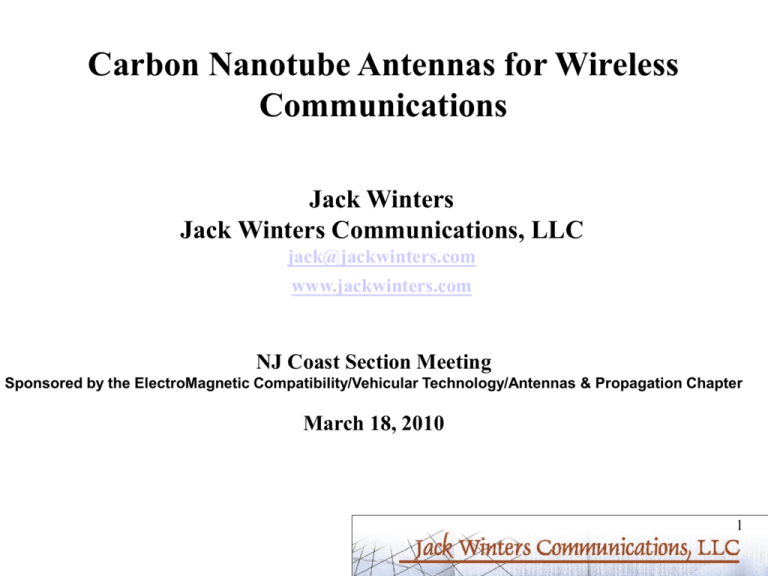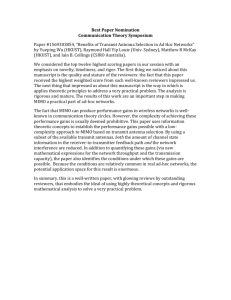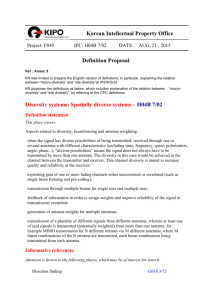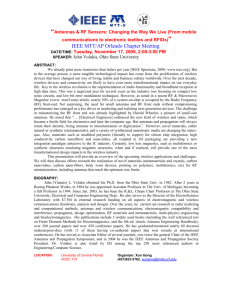slides
advertisement

Carbon Nanotube Antennas for Wireless Communications Jack Winters Jack Winters Communications, LLC jack@jackwinters.com www.jackwinters.com NJ Coast Section Meeting Sponsored by the ElectroMagnetic Compatibility/Vehicular Technology/Antennas & Propagation Chapter March 18, 2010 1 Outline • Overview of Wireless Trends • Carbon Nanotube Antennas • Applications to Wireless Communications • Conclusions 2 Overview Goal: Wireless communications, anywhere, in any form Means: Standard-based heterogeneous networks, since no one wireless network is best in all cases – – Centralized networks – cellular/LTE, WiMax – Decentralized systems – WLANs, Bluetooth, sensor networks – RFID – Multi-mode terminals – Small, ubiquitous devices (RFID, smart dust) 3 Wireless System Evolution Cellular: – 2G – GPRS – 56-114 kbps – 2.5G - EDGE – up to 400 kbps (Evolved EDGE – 1 Mbps) – 3G: • HSPA – 7.2 Mbps (AT&T completed 2009) • HSPA+ 21/42 Mbps – LTE/WiMAX/IMT-Advanced – 100 Mbps and higher • LTE: 50 Mbps UL, 100 Mbps DL (deployment in 2012 by AT&T) 4 (From IEEE Comm. Mag. 1/10) Wireless System Evolution WLAN: 802.11n: >100 Mbps in MAC >3 bits/sec/Hz 802.11ac (< 6GHz) and 802.11ad (60 GHZ) >500 Mbps link throughput >1 Gbps multiuser access point throughput >7.5 bits/sec/Hz (Network throughput is not addressed) RFID: Active and passive tags Read ranges with omni-directional antennas: Active tags (433 MHz) - 300 feet Passive tags (900 MHz) - 9 feet 5 Techniques for Higher Performance • Smart Antennas (keeping within standards): • Range increase • Interference suppression • Capacity increase • Data rate increase using multiple transmit/receive antennas (MIMO) • Radio resource management techniques • Dynamic channel/packet assignment • Adaptive modulation/coding/platform (software defined radio) • Cognitive radio (wideband sensing) 6 Smart Antennas Switched Multibeam Antenna Adaptive Antenna Array SIGNAL BEAMFORMER SIGNAL BEAM SELECT SIGNAL OUTPUT SIGNAL OUTPUT INTERFERENCE INTERFERENCE BEAMFORMER WEIGHTS Smart antenna is a multibeam or adaptive antenna array that tracks the wireless environment to significantly improve the performance of wireless systems. Switched Multibeam versus Adaptive Array Antenna: Simple beam tracking, but limited interference suppression and diversity gain, particularly in multipath environments Adaptive arrays are generally needed for devices and when used for MIMO 7 Key to Higher Data Rates: Multiple-Input Multiple-Output (MIMO) Radio • With M transmit and M receive antennas, can provide M independent channels, to increase data rate M-fold with no increase in total transmit power (with sufficient multipath) – only an increase in DSP. Peak link throughput increase: – Indoors – up to 150-fold in theory – Outdoors – 8-12-fold typical 8 MIMO • LTE/WiMAX/802.11n: 2X2, 4X2, 4X4 MIMO • 802.11ad (60 GHz): – 10 to 100 antennas – Phased array – On chip • 802.11ac (<6 GHz) – 8X4 or 16X2 MIMO => multiple access point/terminal antennas – 80-100 MHz bandwidth => cognitive radio (large networks) 9 RFID – Adaptive Arrays for Readers and Tags • Active and passive tags • Read ranges with omni-directional antennas: • Active tags (433 MHz) - 300 feet • Passive tags (900 MHz) - 9 feet • Reader can use scanning beam to transmit, adaptive array to receive • Tag can use adaptive array to receive, then use same weights to transmit 10 Issues • Large arrays at access point/base station/terminal: – Diversity (for MIMO) in small size • 700 MHz – Low cost/power signal processing – 802.11n: up to 4 on card/computer, but only 1 or 2 at handset – Multiplatform (MIMO) terminals, and the need for multiband/conformal/embedded antennas, increase the problem • Cognitive radio – cross-layer with – MIMO – Wide bandwidth 11 Adaptive Arrays for RFID Tags • Tags can be very small devices (single chip), making multiple antenna placement an issue • At 900 MHz, half-wavelength spacing is 6 inches. 12 Diversity Types Spatial: Separation – only ¼ wavelength needed at terminal (but can’t do at 700 MHz) Polarization: Dual polarization (doubles number of antennas in one location Pattern: Allows even closer than ¼ wavelength => 16 or more on a handset 13 Multiplatform Devices with Smart Antennas • Most systems consider only 2 antennas on devices (4 antennas in future) because of costly A/Ds and size of antennas. Antenna Location 14 Signal Processing: Analog/Switching (RF) or Digital Analog Advantages: • Digital requires M complete RF chains, including M A/D and D/A's, versus 1 A/D and D/A for analog, plus substantial digital signal processing • The cost is much lower than digital (see, e.g., R. Eickhoff, et al, “Developing Energy-Efficient MIMO Radios”, IEEE VT magazine, March 2009) • Switched antennas have even lower cost Digital Advantages: • Slightly higher gain in Rayleigh fading (as more accurate weights can be generated) • Temporal processing can be added to each antenna branch much easier than with analog, for higher gain with delay spread • Needed for spatial processing with MIMO => Use RF combining where possible, minimizing digital combining (limit to number of spatial streams) 15 Combination of Switching, RF, and Digital Combining (Hybrid) “Capacity and Complexity Trade-offs in MIMO Analog–Digital Combining Systems,” Xin Zhou, Jack Winters, Patrick Eggers, and Persefoni Kyritsi, Wireless Personal Communications, July 24, 2009. RF combining in addition to digital combining provides added gain for higher data rates over larger area with reduced cost 16 Closely-Spaced Antennas - Solutions 1) Metamaterials: - Closer spacing with low mutual coupling but good diversity (pattern) and smaller size with directivity (active antennas) - Ex: Rayspan MetarrayTM: - 1/6 wavelength spacing - 1/10 wavelength antenna length 40 x 15mm 4 dBi http://www.rayspan.com/pdfs/Metarray_n_data_sheet_032607.pdf Netgear has implemented metamaterial antennas in their WLANs 17 Closely-Spaced Antennas - Solutions 1) Metamaterials (cont.): - 1/50th of a wavelength demonstrated (http://www.physorg.com/news183753164.html): 18 Closely-Spaced Antennas (cont.) 2) Active antennas: Use of MEMs with metamaterial antennas and carbon nanotube antennas on graphene substrates Frequency agility, reducing the number of antennas Bandwidth/polarization/beampattern adaptation Low cost, small size/form factor solution http://wireless.ece.drexel.edu/publications/pdfs/Piazza_ElecLtr06.pdf 19 Closely-Spaced Antennas (cont.) 3) Superconductivity Can “pull” transmitted power to receiver (requires large currents) 20 4) Carbon Nanotube Antennas Basic features R// • One-atom-thick graphite rolled up into cylinder L D • Wave velocity is 1% of free space 1.7 mm (vs. 17 cm) half-wavelength spacing at 900 MHz 10,000 antennas in same area (106 antennas in same volume) as standard antenna => Very low antenna efficiency – but have pattern diversity => Much stronger than steel for given weight Can be integrated with graphene circuitry for adaptive arrays 21 Carbon Forms ([1] D. Mast – Antenna Systems Conference 2009) 22 Carbon Nano-Forms [1] 23 SWCNT [1] • Length to width of 108 • Current density > metal (3 orders of magnitude greater than copper) • Strength > Steel (2 orders of magnitude stronger by weight) • Thermal Conductivity > Diamond (1 order of magnitude greater than copper) http://en.wikipedia.org/wiki/File:Kohlenstoffnanoroehre_Animation.gif 24 SWCNT Issues [1] • Small diameter (usually no larger than 2 nm) • Short length (usually less than 100 microns) • 1/3 metallic and 2/3 semiconductor (without control of which kind) • Full scale, low cost production • Electrical contact to electronics (graphene electronics) 25 Structure of SWCNTs [1] 26 Implementation SWCNT pillars – connect with array electronics http://www.ou.edu/engineering/nanotube/ 27 Arrays Graphene electronics: • 2 orders of magnitude higher electron mobility than silicon • >30 GHz transistors demonstrated http://arstechnica.com/science/2010/02/graphe ne-fets-promise-100-ghz-operation.ars Antenna Weights 28 SWCNT Radio [1] 29 Multi-Walled Carbon Nanotubes [1] Array on silicon 1.5 mm array Scanning electron microscope image One MWCNT antenna – 24 nm outer, 10 nm inner diameter (transmission electron microscope image) 30 Multi-Walled Carbon Nanotubes – Threads [1] 31 MWCNT Thread in Radio [1] 32 Non-Aligned Carbon Nanotube Antennas High conductivity and flexibility ([2] Zhou, Bayram, Volakis, APS2009) • Non-aligned CNT sheet [3] • Sheet resistivity: ~ 20 / cross section view top view • CNT length: ~200 μm • CNT spacing distance: ~ 100 nm • CNT tips are entangled (touching), giving rise to high conductivity 33 Polymer-CNT Patch Antenna Performance [2] MCT-PDMS substrate, 5 mm 31 mm • CNT patch: 0.9 Ohm/square CNTs sheet • Patch antenna: 5.6 dB gain (compared to 6.4 dB of PEC patch) 8 mm • Radiation efficiency: 83% 150 mm 56 mm Return loss Gain 10 0 -2 5 dBgain (dB) Realized dB (dB) S11 -4 -6 -8 -10 -12 0 -5 Measured CNTs patch -14 -10 Simulated PEC patch -16 -18 1.5 Simulated CNTs patch 2 2.5 Frequency (GHz) 3 -15 1.5 2 2.5 Frequency (GHz) 3 34 Summary and Conclusions • Communication systems increasingly need electrically small, active antennas – multiplatform devices with MIMO, small RFIDs • Carbon nanotube antennas have unique properties including strength, current density, wave velocity, and thermal conductivity. • They can be connected directly to graphene electronics (with high electron mobility) for dense adaptive arrays of SWCNT. • Many issues to be resolved, but substantial innovation opportunity (examples including MWCNT threads and nonaligned SWCNT sheets). 35
![EEE 443 Antennas for Wireless Communications (3) [S]](http://s3.studylib.net/store/data/008888255_1-6e942a081653d05c33fa53deefb4441a-300x300.png)



